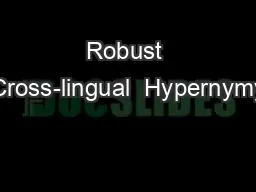

Detection using Dependency Context Shyam Upadhyay Yogarshi Vyas Dan Roth Marine Carpuat Monolingual Hypernymy Detection 2 squirrel r odent ie is a kind of Hypernym ID: 812882
Download The PPT/PDF document "Robust Cross-lingual Hypernymy" is the property of its rightful owner. Permission is granted to download and print the materials on this web site for personal, non-commercial use only, and to display it on your personal computer provided you do not modify the materials and that you retain all copyright notices contained in the materials. By downloading content from our website, you accept the terms of this agreement.
Slide1
Robust Cross-lingual Hypernymy Detection using Dependency Context
Shyam Upadhyay*
Yogarshi
Vyas
*
Dan Roth Marine
Carpuat
Slide2(Mono-lingual) Hypernymy Detection
2
squirrel
r
odent
(i.e., is a kind of?)
Hypernym
?
✔
Slide3Cross-lingual Hypernymy Detection
Potential Applications
Multi-lingual Taxonomy Construction
(
Fu et al., 2014
)Cross-lingual
Textual Entailment (Negri et al., 2012, 2013)Event Coreference across multi-lingual news sources (Vo
ssen et al. 2015)Evaluating Machine Translation output (Pado et al. 2009)écureuil
(French)
r
odent
ворона
(Russian)
f
ruit
البرتقالي
(Arabic)
bird
喇叭
(Chinese)
instrument
✔
✔
✔
3
Slide4Why is this Challenging?
4
cook
leader
supervisor
chef
Translation does not capture language specific usage patterns.
Multilingual lexical resources (e.g.,
Babelnet
) are useful, but incomplete.
Can we
directly
detect cross-lingual
hypernymy
using a
distributional
approach?
chronicler
c
hroniqueur
journalist
Slide5Overview of Our Approach
5
We also demonstrate robustness of this framework in various low-resource settings.
FR Corpus
EN Corpus
Dependency Context
s
Dependency
Context
s
pomme
fruit
Hypernymy
Scorer
Yes!
Slide6Dependency-Based Context Representations
6
Context Type
Example (for target word:
traveler
)
Window
tired, roamed
Dep
-Full
(
Pado
and
Lapata
2007, Levy and Goldberg 2014
)
roamed#nsubj
-1
,
tired#amod
Dep
-Joint
(
Chersoni
et al. 2016)
roamed#desert
,
roamed#seeking
Gives state of the art results in monolingual
hypernymy
detection.
(Roller and
Erk
2016,
Shwartz et al. 2017)Dependency contexts abstract away language specific word order.
Slide7How to detect hypernymy
using context features?
Symmetric measures like cosine similarity cannot detect asymmetric relations.
Distributional
Inclusion
Hypothesis (DIH) (Geffet and Dagan, 2005)“Reptile” can replace “snake” in its contexts, but not the other way round.
Scoring word pairs for DIH,
7v is a hypernym
of u, if context features of u appear
within the features of v.
(
Kotlerman
et al. 2009)
a
symmetric
“inclusiveness” score
symmetric
similarity score
“snake”
“reptile”
Slide8How to compare context features across languages?
8
v
is
a hypernym of
u, if context features of u
appear within the features of v.
Slide9children
enfants
money
argent
loi
law
monde
world
peace
paix
market
marche
Bi-lingual Representations = Continuous Approx. of Translation Dictionaries
9
Vectors in English
Vectors in French
English
French
children
enfants
law
loi
money
argent
world
??
??
paix
??
marche
Klementiev
et al. (COLING 2012)
Faruqui
and Dyer (EACL 2014)
Sogaard
et al. (ACL 2015)
and many others
…
Slide1010
Generate bilingual representations ,
that can
be used
with
the distributional inclusion hypothesis,using monolingual dependency context representations ,and a bilingual dictionary
Slide11Bilingual Sparse Coding
11
Mono. Obj. for Sparse Coding
Cross-ling. Obj. to respect translation matrix
INPUT:
Monolingual Dense Vector for
i
th
word
OUTPUT:
Bilingual Sparse Vector for
i
th
word
Lasso Reg.
m
atrix encoding all possible translations
Minimize distance of words which are possible translations of each other
(
Vyas
and
Carpuat
2016)
Slide12Putting it all Together …
12
FR Corpus
EN Corpus
Dep. Parser
Dep. Parser
Parsed Corpus
Parsed Corpus
Bilingual Sparse Coding
Bilingual Dictionary
p
omme
(apple in French)
fruit
BalAPinc
Scorer
0.8
co-occurrence
matrix
SVD
SVD
Dep.-Based Context Extraction
Dep.-Based Context Extraction
co-occurrence
matrix
Slide1313
Experiments
Slide14Evaluation Setup
Crowd-sourcing evaluation datasets
C
andidate edges drawn from monolingual
hypernymy datasets,
Babelnet, …
Two evaluation setsHypernymy vs
Hyponymy (i.e., reverse relation, e.g. (reptile,snake) vs. (snake,reptile))Hypernymy vs Cohyponymy (i.e., words sharing the same hypernym, e.g. (lizard,snake))
Evaluation Metric: Accuracy
14
Lang.
#
pos
(= #
neg
)
French-English
763
Russian-English
706
Arabic-English
691
Chinese-English
806
Slide15Main Results – Hyper vs
Hypo
15
Slide16Main Results – Hyper
vs
Cohypo
16
Distinguishing
h
ypernyms from cohyponyms is easier than distinguishing them from hyponyms.
Slide17Evaluating Robustness in Low-Resource Settings
17
Slide18Low-Resource Setting - Absence of Treebank
Our
approach
requires a dependency parser in the target language.
Dependency
treebanks are not available for most of the languages in the world.Can we use a (
delex) dependency parser trained on related languages?
18French English
Spanish
PortugueseItalian
Zeman
and
Resnik
, 2008;
McDonald
et al., 2011
Slide19Robustness to Absence of Treebank (Hyper vs Hypo)
19
Slide20Robustness to Absence of Treebank (Hyper vs
Cohypo
)
20
Frequent contexts -
amod
,
nmod
, nsubj, dobj together make >70% of all matrices.
Delexicalized parsers are relatively robust on these frequent
contexts
.
Slide21Other Low-Resource Settings
21
r
educe size of monolingual corpus
r
educe quality of the bilingual dictionary
Fairly robust to these settings as well!
Slide22Our Contributions
We
can identify
hypernymy relations across languages using
dependency based cross-lingual representations.
Framework is robust to various low-resource settings.New datasets
for cross-lingual hypernymy detection in 4 languages.Evaluation datasets and vectors available at
github.com/yogarshi/bisparse-dep
22
pomme
fruit
Entailment Scorer
0.8
Thanks!
Slide23Reason for Robustness
F
requent contexts in the dependency context co-occurrence matrix
amod
, nmod
, nsubj,
dobj together make >70% of all matrices. Delexicalized parsers are relatively robust on these frequent contexts.
Most other contexts suffer 15-20 F1 drops.This makes our framework applicable to many more languages!
23
Lang.
F1 on
nmod
edge
F1 on
nmod
edge
(DELEX )
Russian
76.7
68.6
French
76.8
69.6
Arabic
76.1
71.2
Chinese
75.4
69.7